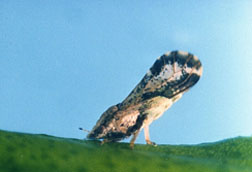This page has been archived and is being provided for reference purposes only. The page is no longer being updated, and therefore, links on the page may be invalid.
Read the magazine story to find out more. |
|
|
Test Detects Insect Carriers of Citrus Greening Disease
By Marcia WoodOctober 23, 2009
With their pleasing flavor, cheerful color, and health-imparting dose of vitamin C, it's not surprising that oranges are one of America's Top 10 favorite fruits. But some of the nation's citrus groves are threatened by a microbe that causes citrus greening disease, and by a tiny insect that carries this microbe.
To help protect citrus, Agricultural Research Service (ARS) plant pathologists Richard F. Lee and Keremane L. Manjunath developed a test that reveals whether tiny insects called Asian citrus psyllids are in fact carrying Candidatus Liberibacter asiaticus, one of three microbial species thought to cause the disease.
Developed over the past several years and reported in a 2008 article in the journalPhytopathology, the test is being used today by plant health officials in the United States and elsewhere.
Assaying psyllids may provide a way to detect citrus greening disease up to two years before symptoms become apparent in afflicted plants, according to the scientists. They're based at the ARS National Clonal Germplasm Repository for Citrus and Dates in Riverside, Calif.
First detected in the United States—in Florida—in 2005, citrus greening or citrus Huanglongbing disease (HLB) has already infected millions of citrus trees in that state, and has also shown up in Georgia, Louisiana and South Carolina.
Though not the first to detect HLB in Asian citrus psyllids, the assay apparently still is one of the newest of its kind to be based on what's known as "real-time qPCR" (short for "quantitative polymerase chain reaction") technology. The test is comparatively quick and relatively inexpensive, and can be performed by technicians working in any of the labs across the country that already handle PCR assays.
The scientists have used the assay to test more than 10,000 psyllids, Diaphorina citri, collected from orchards, backyards, retail nurseries and other venues in Florida where citrus plants are grown or sold.
The assay is one of the many accomplishments from ARS research laboratories nationwide that strengthen international food security—a top priority of the U.S. Department of Agriculture.
Read more about the research in the October 2009 issue of Agricultural Research magazine.
ARS is USDA'S principal intramural scientific research agency.


